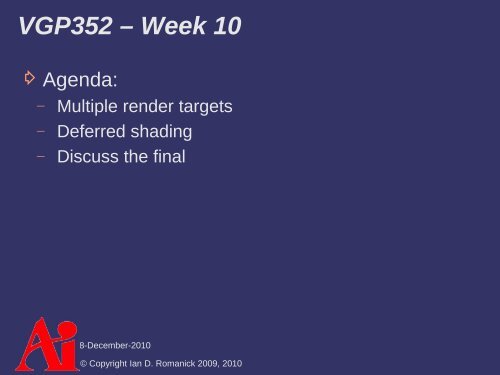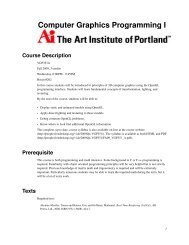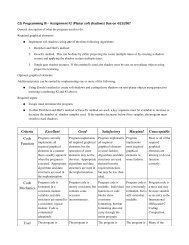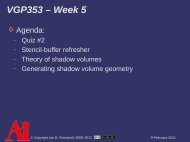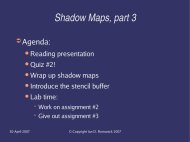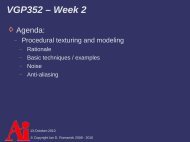You also want an ePaper? Increase the reach of your titles
YUMPU automatically turns print PDFs into web optimized ePapers that Google loves.
VGP352 – Week 10<br />
⇨ Agenda:<br />
Multiple render targets<br />
Deferred shading<br />
Discuss the final<br />
8-December-2010<br />
© Copyright Ian D. Romanick 2009, 2010
MRT<br />
⇨ Multiple color outputs from the fragment shader<br />
For practical purposes, requires the use of<br />
framebuffer objects<br />
Slightly changes GLSL syntax<br />
8-December-2010<br />
© Copyright Ian D. Romanick 2009, 2010
MRT<br />
Uniforms<br />
Textures<br />
Varying 0<br />
Varying 1<br />
Varying m<br />
Fragment<br />
Shader<br />
Fragment Colors<br />
Fragment Depth<br />
Window Pos.<br />
Point Coordinate<br />
Facing<br />
8-December-2010<br />
© Copyright Ian D. Romanick 2009, 2010
Framebuffer Objects<br />
⇨ Attach one or more renderable objects to it<br />
1D, 2D, and 3D versions exist<br />
void glFramebufferTexture2DEXT (GLenum target,<br />
GLenum attachment, GLenum textarget,<br />
GLuint texture, GLint level);<br />
void glFramebufferRenderbufferEXT(<br />
GLenum target, GLenum attachment,<br />
GLenum renderbuffertarget,<br />
GLuint renderbuffer);<br />
Selects how the buffer is used:<br />
Color buffer: GL_COLOR_ATTACHMENT0<br />
Depth buffer: GL_DEPTH_ATTACHMENT<br />
8-December-2010<br />
Stencil buffer: GL_STENCIL_ATTACHMENT<br />
© Copyright Ian D. Romanick 2009, 2010
MRT – FBO Usage<br />
⇨ Use additional color attachments<br />
e.g. GL_COLOR_ATTACHMENT1<br />
Maximum number of attachments queryable with<br />
GL_MAX_COLOR_ATTACHMENTS<br />
EXT_fbo requires that all color attachments have the<br />
same internal format<br />
ARB_fbo / OpenGL 3.0 allow drivers to relax this restriction<br />
The driver can still reject a particular combination<br />
Most hardware can handle combinations with the same size<br />
internal formats<br />
e.g. GL_RGBA8 with GL_RGBA_10_10_10_2<br />
8-December-2010<br />
© Copyright Ian D. Romanick 2009, 2010
MRT – Setting Draw Buffers<br />
⇨ Connect attachments with shader outputs:<br />
void glDrawBuffers(GLsizei n,<br />
const GLenum *bufs);<br />
bufs gives a list of attachments points to connect, in<br />
the specified order, with shader outputs<br />
Shader output 0 gets the first listed attachment, output 1 gets<br />
the second, etc.<br />
Maximum number of outputs queryable with<br />
GL_MAX_DRAW_BUFFERS<br />
8-December-2010<br />
© Copyright Ian D. Romanick 2009, 2010
MRT – GLSL Usage<br />
⇨ gl_FragColor is but one output. What to do?<br />
Replace with a new output that is declared as an<br />
array:<br />
vec4 gl_FragData[];<br />
Each element in gl_FragData corresponds to one of<br />
the outputs set by glDrawBuffers<br />
8-December-2010<br />
© Copyright Ian D. Romanick 2009, 2010
References<br />
Jones, Rob. “OpenGL Frame Buffer Object 201.” GameDev.net.<br />
December 14th, 2006. Accessed on June 10th, 2009.<br />
http://www.gamedev.net/reference/articles/article2333.asp<br />
8-December-2010<br />
© Copyright Ian D. Romanick 2009, 2010
Deferred Shading<br />
⇨ Scenes with high depth complexity or many<br />
lights suffer from several problems:<br />
Many passes to implement the lights<br />
Lots of wasted fragment processing<br />
Difficulty with per-batch storage for shadow maps<br />
Difficulty with stencil shadows from multiple lights<br />
etc.<br />
End result: poor performance<br />
8-December-2010<br />
© Copyright Ian D. Romanick 2009, 2010
Deferred Shading<br />
⇨ What if we could easily:<br />
Light each pixel (not fragment) exactly once<br />
Only apply lights to the fragments they affect<br />
Reduce per-light cost in scenes with many lights<br />
8-December-2010<br />
© Copyright Ian D. Romanick 2009, 2010
Deferred Shading<br />
⇨ General idea:<br />
Render scene information needed for shading to an<br />
off-screen geometry buffer (G-buffer)<br />
Draw per-light geometry to screen sampling from G-<br />
buffer to calculate shading<br />
8-December-2010<br />
© Copyright Ian D. Romanick 2009, 2010
Deferred Shading – G-Buffer<br />
⇨ All per-fragment data required for shading:<br />
Normal<br />
Position<br />
Diffuse / specular color<br />
etc.<br />
⇨ Emit this during per-object rendering<br />
Output this data instead of performing lighting<br />
calculations<br />
Use MRT!<br />
8-December-2010<br />
© Copyright Ian D. Romanick 2009, 2010
Deferred Shading – G-Buffer<br />
⇨ Example G-buffer layout:<br />
2 RGBA16F outputs:<br />
Diffuse (red) Diffuse (green) Diffuse (blue) m<br />
Normal (X) Normal (Y) Normal (Z) n<br />
m is the Cook-Torrance roughness<br />
n is the index of refraction<br />
8-December-2010<br />
© Copyright Ian D. Romanick 2009, 2010
Deferred Shading – G-Buffer<br />
⇨ Tough choices:<br />
Explicitly store position or derive from screen X/Y and<br />
depth value?<br />
Explicitly store the normals Z or derive from its X and<br />
Y?<br />
One of the most important parts of designing a<br />
deferred shading engine is selecting the parameters<br />
and the packing<br />
8-December-2010<br />
© Copyright Ian D. Romanick 2009, 2010
Deferred Shading – G-Buffer<br />
⇨ CryEngine 3 stores normals in 2 components<br />
Encode:<br />
normal_g = normalize(normal.xy) *<br />
sqrt((normal.z / 2.0) + 0.5);<br />
Decode:<br />
normal.z = (length(normal_g.xy) * 2.0) – 1.0;<br />
normal.xy = normalize(normal_g.xy) *<br />
sqrt(1.0 (normal.z * normal.z);<br />
Very similar to the mapping for spherical reflection<br />
maps<br />
More expensive to compute, but has better precision<br />
8-December-2010<br />
© Copyright Ian D. Romanick 2009, 2010
Deferred Shading – Lighting<br />
⇨ For each light, draw simplified bounding<br />
geometry<br />
Perform lighting for each fragment drawn<br />
Only light the areas of the scene that need lighting<br />
Read from G-buffer at the screen X/Y position<br />
Add calculated lighting to existing values<br />
Examples:<br />
Directional light: box<br />
Point light: sphere<br />
Spot light: cone<br />
8-December-2010<br />
© Copyright Ian D. Romanick 2009, 2010
Deferred Shading – Lighting<br />
⇨ Optimize by letting the early stencil test discard<br />
many fragments<br />
Draw the light volume once:<br />
Disable color writes<br />
Set depth function to GL_LESS and stencil function to<br />
GL_ALWAYS<br />
Set Z-fail stencil operation to GL_REPLACE and all others to<br />
GL_KEEP<br />
Draw the light volume again:<br />
Enable color writes<br />
Set depth function to GL_LEQUAL and stencil function to<br />
GL_EQUAL<br />
Set 8-December-2010 all stencil operations GL_KEEP<br />
© Copyright Ian D. Romanick 2009, 2010
Deferred Shading – Lighting<br />
Light volume<br />
8-December-2010<br />
© Copyright Ian D. Romanick 2009, 2010
Deferred Shading – Lighting<br />
Light volume<br />
8-December-2010<br />
© Copyright Ian D. Romanick 2009, 2010
Deferred Shading – Lighting<br />
Light volume<br />
Z fails<br />
on first<br />
pass<br />
Z passes<br />
on second<br />
pass<br />
8-December-2010<br />
© Copyright Ian D. Romanick 2009, 2010
Deferred Shading – Drawbacks<br />
⇨ What could go wrong?<br />
8-December-2010<br />
© Copyright Ian D. Romanick 2009, 2010
Deferred Shading – Drawbacks<br />
⇨ What could go wrong?<br />
Transparency effects won't work<br />
Traditional anti-aliasing (multisampling) has problems<br />
8-December-2010<br />
© Copyright Ian D. Romanick 2009, 2010
References<br />
Hargreaves, S., Harris, M. “Deferred Shading.” Nvidia 6800 Leagues<br />
Under the Sea. June 2004.<br />
http://developer.nvidia.com/object/6800_leagues_deferred_shading.html<br />
Fabio Policarpo, Francisco Fonseca, Deferred shading tutorial.<br />
Pontifical Catholic University of Rio de Janeiro. 2005.<br />
http://www710.univ-lyon1.fr/~jciehl/Public/educ/GAMA/2007/Deferred_Shading_Tutorial_SBGAMES2005.pdf<br />
Shishkovtsov, Oles. "Deferred Shading in S.T.A.L.K.E.R." in<br />
Fernando, Randima (editor) GPU Gems 2, Addison Wesley,<br />
2005.<br />
http://http.developer.nvidia.com/GPUGems2/gpugems2_chapter09.html<br />
Mittring, M. “A bit more deferred – CryEngine3.” Triangle Game<br />
Conference 2009. http://www.crytek.com/technology/presentations/<br />
8-December-2010<br />
© Copyright Ian D. Romanick 2009, 2010
Global Illumination<br />
⇨ Can deferred shading be used to implement<br />
global illumination?<br />
Yes, but...<br />
Only for a single “bounce”<br />
Only for diffuse inter-reflections<br />
⇨ Deferred shading makes using many lights very<br />
cheap<br />
Where many can mean 100's<br />
Generate a bunch of fake lights that represent the<br />
reflection of light from surfaces<br />
Call these virtual point lights (VPLs)<br />
8-December-2010<br />
© Copyright Ian D. Romanick 2009, 2010
Virtual Point Lights<br />
⇨ Generate VPLs:<br />
Trace paths from each light to first intersection<br />
This determines the position of the VPL<br />
Treat all VPLs as 180˚ spot lights<br />
Calculate reflection at intersection<br />
This determines the intensity of the VPL<br />
8-December-2010<br />
© Copyright Ian D. Romanick 2009, 2010
References<br />
Samuli Laine, Hannu Saransaari, Janne Kontkanen, Jaakko<br />
Lehtinen, and Timo Aila. “Incremental Instant Radiosity for Real-<br />
Time Indirect Illumination.” Eurographics Symposium on<br />
Rendering 2007. http://www.tml.tkk.fi/~timo/<br />
8-December-2010<br />
© Copyright Ian D. Romanick 2009, 2010
Next week...<br />
⇨ The final<br />
8-December-2010<br />
© Copyright Ian D. Romanick 2009, 2010
Legal Statement<br />
This work represents the view of the authors and does not necessarily<br />
represent the view of Intel or the Art Institute of Portland.<br />
OpenGL is a trademark of Silicon Graphics, Inc. in the United States, other<br />
countries, or both.<br />
Khronos and OpenGL ES are trademarks of the Khronos Group.<br />
Other company, product, and service names may be trademarks or service<br />
marks of others.<br />
8-December-2010<br />
© Copyright Ian D. Romanick 2009, 2010


